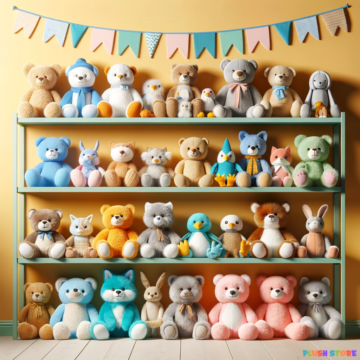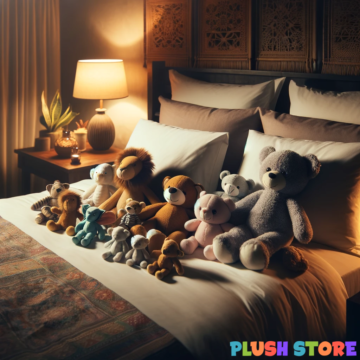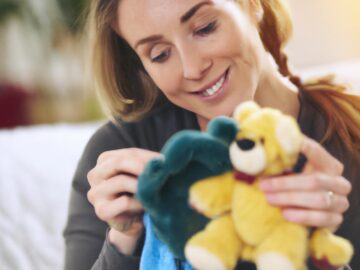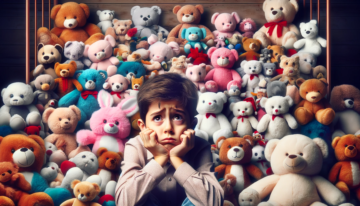
Introduction: Stuffed animals and plush toys have been long-standing companions for children, often seen as a source of comfort and joy. However, like all good things, moderation is key. This article delves into the less discussed aspects of having too many plush toys and how it can impact a child’s development, health, and environment.
Table of Contents
- The Psychological Impact of Excessive Plush Toys
- Developmental Considerations
- Health and Hygiene Concerns
- Environmental and Space Issues
- Quality over Quantity
- Balancing Plush Toy Collections
- Conclusion
The Psychological Impact of Excessive Plush Toys
While stuffed animals can be a source of comfort, an overabundance can create a paradox of choice for children. With too many options, a child might struggle to make simple decisions, leading to decision fatigue. This phenomenon, where an excess of choices leads to a decreased ability to make decisions, can be overwhelming for young minds. It’s not just about selecting a toy to play with; this indecisiveness can extend to other areas of life, affecting their ability to make choices confidently.
Moreover, excessive emotional attachment to a large number of toys can hinder the development of coping mechanisms needed to deal with loss or change. Children who form deep bonds with a multitude of toys may find it challenging to understand and cope with the concept of loss or the need to let go. This aspect is crucial as it plays a significant role in their emotional maturity. It’s essential for children to learn that while it’s okay to form attachments, it’s also a part of life to move on or away from certain things as they grow.
Additionally, a large collection of plush toys can inadvertently lead to a sense of entitlement or reduce the value and appreciation a child has for each individual toy. When a new stuffed animal is added to an already extensive collection, it might not hold the same value or bring the same level of joy as it would in a more modest collection. This desensitization to new additions can extend beyond toys, affecting their ability to appreciate and value new experiences or possessions in general.
Finally, a key psychological aspect to consider is the impact on social skills. Children with too many toys, including plush toys, may prefer solitary play over interactive play with other children. This preference can impact their social development, as interactive play is crucial for learning social cues, empathy, and cooperation. A curated selection of toys can encourage children to engage more with their peers, share their toys, and develop essential social skills.
Developmental Considerations
Child development experts often emphasize the importance of quality over quantity in play. An excess of plush toys can stifle creativity and imaginative play, as children might not learn to improvise or use their toys in versatile ways. When presented with fewer toys, children are often more creative and resourceful, finding new and imaginative ways to use each toy. This kind of play is critical in developing cognitive skills, such as problem-solving and critical thinking.
Moreover, having too many plush toys can lead to shorter attention spans. Children might flit from one toy to another without fully engaging or exploring each one’s potential. This lack of deep engagement can affect their ability to concentrate and focus, skills that are important for academic learning and general life skills. Encouraging children to spend more time with each toy helps them develop patience and persistence, as they find new ways to interact with the same object over time.
In addition, a limited number of toys can foster a child’s ability to play independently. This independence in play is crucial for self-esteem and self-efficacy. When children are left to their own devices with a manageable number of toys, they learn to rely on themselves for entertainment and satisfaction, rather than expecting external factors to provide it. This skill is vital for their overall mental and emotional development.
From a language development perspective, playing with fewer toys can also be beneficial. Interactive play with parents or caregivers, where there is a dialogue about the toys and the play scenario, can be more focused and enriching with fewer distractions. This focused interaction can help in developing language and communication skills, as the child learns to express their thoughts and feelings about the play.
Finally, a curated selection of toys encourages deeper emotional development. When children have fewer toys, they often form stronger attachments to each one. These attachments can be instrumental in teaching children about care, empathy, and responsibility. Taking care of a beloved plush toy can be a child’s first step in understanding how to care for others, an essential component of emotional intelligence.
Health and Hygiene Concerns
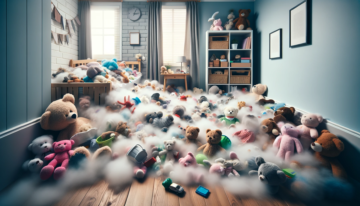
Stuffed animals are notorious for harboring dust mites and allergens, posing health risks, especially in large numbers. These soft toys can become a reservoir for dust, pollen, and other allergens, which can trigger allergic reactions, asthma, and other respiratory issues in children. The risk is heightened when the collection of plush toys is large, as it becomes more difficult to keep them all clean and free from dust and allergens.
Regular cleaning and maintenance of plush toys are crucial for maintaining a healthy environment. However, when a child owns a vast number of stuffed animals, cleaning each one properly becomes a daunting and often neglected task. Dust and allergens accumulate over time, and the toys could become a health hazard rather than a source of comfort. Parents and caregivers might find it challenging to routinely wash and dry every single toy, especially if they require special care or are of varying materials and sizes.
Additionally, older or hand-me-down stuffed animals can pose a greater risk. These toys may have been exposed to various environments and might carry more dust mites and allergens. It’s important to inspect and clean these toys thoroughly before introducing them to a child’s collection.
Beyond allergens, plush toys can also harbor bacteria and viruses if not cleaned regularly. This is particularly concerning considering children’s tendency to cuddle, kiss, and sometimes chew on their stuffed animals. Without proper hygiene practices, these toys can become vectors for illness.
Moreover, the upkeep of a large number of stuffed animals can become overwhelming, leading to cluttered spaces which themselves can be detrimental to health. A cluttered environment can increase stress and anxiety levels in both children and adults, further impacting overall well-being. It can also make it difficult to clean the room effectively, allowing dust and allergens to accumulate not only on the toys but in the child’s living space as a whole.
It’s therefore crucial for parents to balance the emotional benefits of plush toys with the practical aspects of health and hygiene. A manageable number of toys allows for better maintenance, ensuring a cleaner, healthier environment for children.
Environmental and Space Issues
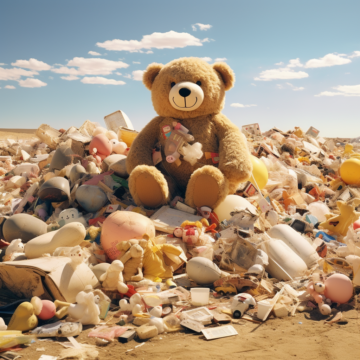
The environmental impact of producing, shipping, and eventually disposing of excessive plush toys is significant. The production of these toys often involves the use of synthetic materials and chemicals, which can be harmful to the environment. The process of manufacturing, from the extraction of raw materials to the final product, contributes to carbon emissions and environmental degradation. Additionally, the shipping of these toys, often manufactured overseas, adds to the carbon footprint due to the fuel consumption and emissions associated with long-distance transportation.
Moreover, the disposal of plush toys poses its own set of environmental challenges. Many stuffed animals are not biodegradable or recyclable due to the materials used in their production. As a result, they often end up in landfills, where they can take decades to decompose, releasing chemicals and contributing to pollution. The increasing trend of ‘fast toys’, similar to fast fashion, where toys are cheaply made and quickly discarded, exacerbates this environmental issue.
From a spatial standpoint, managing a large collection of plush toys can be challenging for families, especially those living in smaller spaces. Excessive toys can lead to cluttered and disorganized living areas, which can negatively impact mental well-being. A cluttered space can increase stress and anxiety and can hinder a child’s ability to focus and learn. An organized and calm environment is essential for a child’s healthy growth and development, and too many toys can disrupt this balance.
Furthermore, the issue of clutter goes beyond mere aesthetics; it can pose safety hazards as well. Stuffed animals strewn around can increase the risk of accidents, such as tripping and falling, particularly in homes with limited space. Keeping the number of toys to a manageable level can help in maintaining a safer and more harmonious environment for children to play and learn.
Thus, the environmental and spatial considerations surrounding plush toys are multifaceted. It’s not just about the immediate joy these toys bring, but also about the longer-term implications for the planet and the living spaces we inhabit. Encouraging a more mindful and sustainable approach to toy consumption can have a positive impact on both the environment and our personal living spaces.
Quality over Quantity
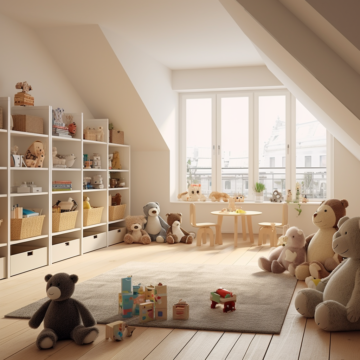
Focusing on high-quality, durable, and educationally enriching plush toys can offer more value than a larger collection of lower quality. High-quality toys are typically made with better materials, ensuring longevity and safety. These toys resist wear and tear, meaning they can withstand the rigors of playtime without quickly ending up in a landfill. Durable toys not only provide a better investment in the long run but also help teach children the value of taking care of their possessions.
Moreover, educationally enriching plush toys often come with added benefits. They may be designed to stimulate a child’s developmental skills, such as sensory toys with different textures to explore, or toys that incorporate elements of basic learning like numbers, letters, or shapes. Engaging with such toys can be more fulfilling for a child, providing both fun and a learning experience.
Another significant aspect of choosing quality over quantity is the emotional connection that children form with their toys. A well-made, cherished plush toy can become a treasured companion, providing comfort and security to a child. These deep emotional bonds are less likely to be formed with a multitude of lesser-quality toys, as each toy in a large collection may not hold as much individual significance.
Environmentally, choosing fewer, higher-quality toys is also more sustainable. It reduces the demand for mass-produced, low-quality items, thereby decreasing the overall environmental impact associated with the production and disposal of toys. Moreover, high-quality toys are more likely to be kept and cherished for longer, or even passed down to younger siblings or other children, further extending their life and reducing waste.
Additionally, investing in quality toys can have financial benefits. While the initial cost might be higher, these toys often require fewer replacements, making them more cost-effective over time. Parents can avoid the constant cycle of buying, discarding, and replacing toys, which not only saves money but also reduces consumer waste.
In summary, opting for quality over quantity when it comes to plush toys can lead to a more enriching experience for children. It encourages a deeper appreciation for their toys, supports their developmental needs, and aligns with environmentally conscious parenting. This approach also fosters a sense of mindfulness and responsibility in children regarding their possessions and the environment.
Balancing Plush Toy Collections
Parents can adopt various strategies to manage plush toy collections effectively. One practical approach is establishing a ‘one in, one out’ rule. This rule means that for every new toy that comes into the home, one must be given away. This strategy not only helps in maintaining a manageable number of toys but also teaches children about moderation and the value of giving. It’s an excellent way to instill a sense of charity and empathy in children, as they learn to part with their possessions for the benefit of others.
Regularly donating toys to charities, shelters, or hospitals is another wonderful way to balance a toy collection. It can be a heartwarming and educational experience for children to choose toys to donate, understanding that their actions can bring joy to other children. This practice encourages children to think beyond their immediate environment and fosters a sense of community and compassion.
Involving children in the process of selecting which toys to keep is also beneficial. This involvement not only makes the decluttering process easier but also helps children develop decision-making skills. It allows them to exercise autonomy and learn to prioritize, understanding that they can’t keep everything and need to make thoughtful choices about what’s important to them.
Setting up a toy rotation system is another effective strategy. By rotating toys in and out of storage, children get the excitement of ‘new’ toys periodically without the need to constantly acquire more. This system keeps their play area fresh and interesting while avoiding the overwhelm of too many choices at once. It also encourages children to fully engage with each toy, exploring its possibilities to the fullest before moving on to the next set.
Creating a display area for the most cherished plush toys can be a way to honor and appreciate them. By designating a special place in the home for a few favorite stuffed animals, children learn to cherish and take pride in their collections. This practice also helps in reducing clutter and keeping the play area organized.
Lastly, educating children about the value and impact of their toys can be enlightening. Discussing topics like the environmental impact of toys, the importance of quality, and the joy of sharing with others can be eye-opening for them. This education can guide their future decisions about toys and help them understand the bigger picture beyond just the immediate joy of owning them.
Implementing these strategies can help parents and children alike find a healthy balance in their plush toy collections. It’s about creating a mindful approach to toys, one that values quality, responsibility, and empathy, leading to a more fulfilling and organized play experience.
Conclusion
While plush toys can be wonderful, it’s important to strike a balance. Moderation in the number of toys not only supports a child’s development and health but also instills values of minimalism and environmental consciousness. The journey through childhood should be enriched with meaningful experiences and lessons, and the toys we choose for our children play a significant role in this journey. By being mindful of the quantity and quality of plush toys, we can create a nurturing environment that fosters creativity, learning, and emotional well-being.
It is essential to recognize that the benefits of plush toys extend beyond mere play. They can be tools for teaching life skills, such as empathy, responsibility, and environmental stewardship. When we limit the number of these toys, we help children to value what they have, to care for their belongings, and to understand the importance of giving and sharing. This approach also encourages a healthier lifestyle, both physically, in terms of reducing allergens and clutter, and mentally, in promoting a sense of calm and order.
Furthermore, adopting a more sustainable approach to toy consumption is not only beneficial for our children but also for the planet. By choosing fewer, higher-quality toys, we contribute to reducing waste and preserving the environment. This action sends a powerful message to the next generation about the importance of caring for our world and being conscious consumers.
In conclusion, the way we handle plush toy collections in our homes has far-reaching implications. It’s about finding a balance that benefits our children’s development, our families’ well-being, and the health of our planet. The mindful selection, maintenance, and management of plush toys can lead to a more organized, healthy, and environmentally friendly lifestyle. By doing so, we prepare our children not just for the present but also for a responsible and conscious future.

